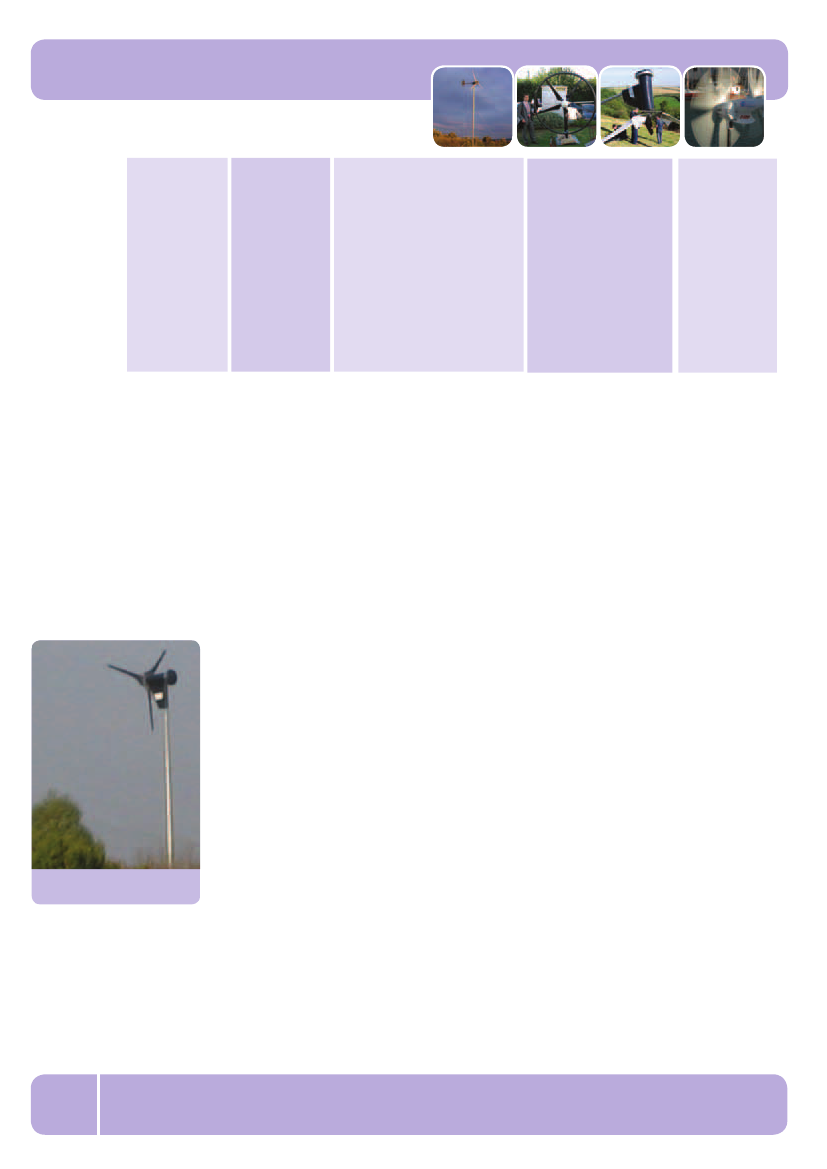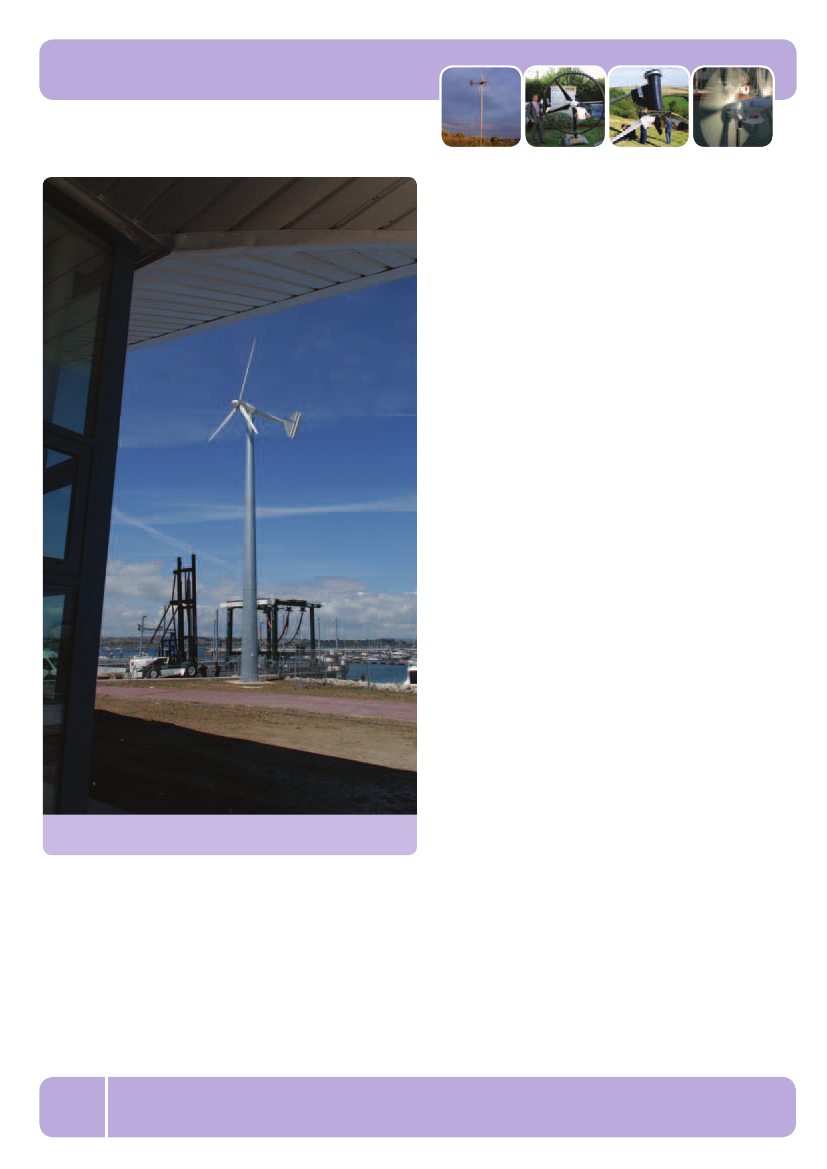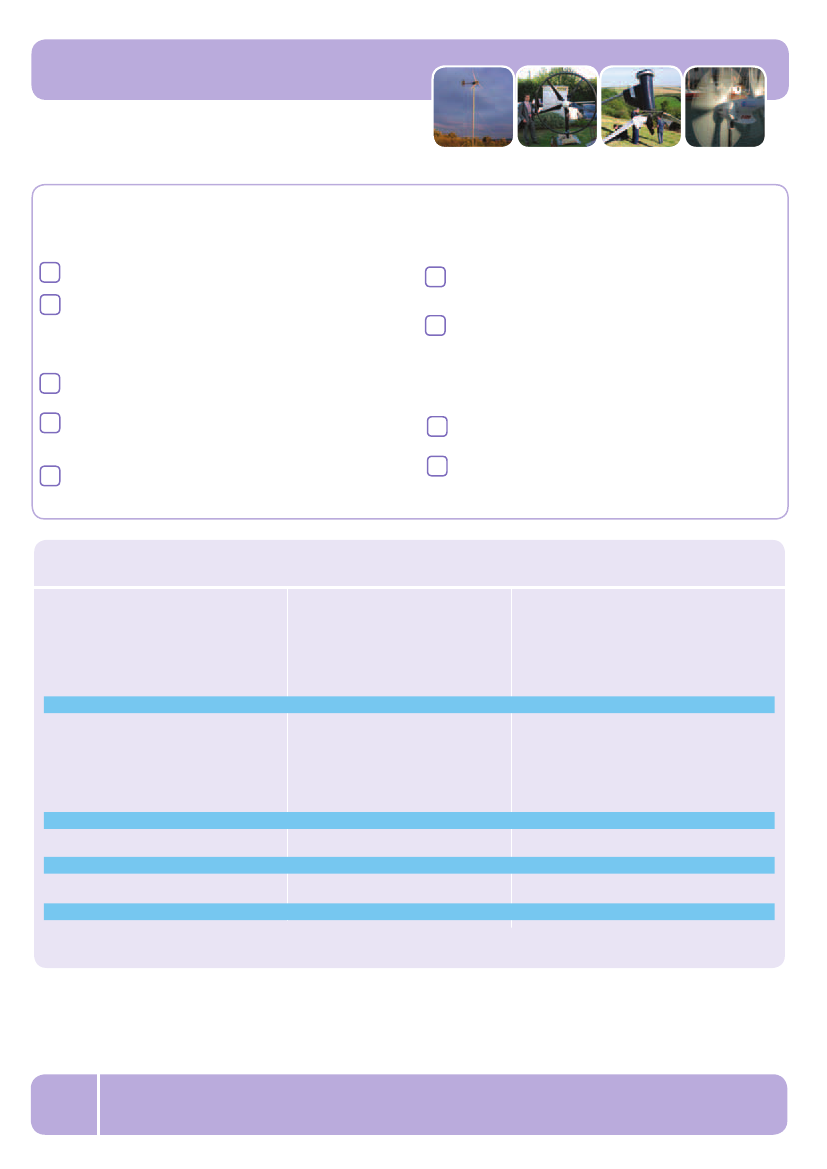Klima-, Energi- og Bygningsudvalget 2012-13
KEB Alm.del Bilag 102
Offentligt
r e n e w a b l e
e n e r g y
Small scale windpowerWhat is it?Wind turbines extractpower from the wind with arotor that typically consistsof three or more bladeswhich can be mounted on ahorizontal axis or nacelle, ora vertical axis. Horizontal axiswind turbines are by far themost common. They rangefrom small 100 watt microturbines used to charge12-24 volt batteries to 20A 2.5kW Proven wind turbinekilowatts (kW) machinesMarshwood School, Dorsetwhich can export electricityto the grid duringtimes when more electricity isproduced than can be used. Smaller models canbe roof mounted whilst larger turbines tend to bemounted on masts up to 15 metres high. They areparticularly useful where mains electricity is notavailable or is expensive to connect. There are about650 small scale wind turbine installations in the UKand approximately 20 in Dorset.Can I produce all my electricity requirements usingthis technology?The annual power outputy of a turbine depends onthe blade length of your chosen turbine, the averagewind speed of your site, and the site not beingobstructed by other buildings or trees. You can findthe average annual wind speed for your postcodefrom the British Wind Energy Association website(www.bwea.com/noabl). You may alternatively wish tomonitor your site with an anemometer which can bebought from companies such as Wind and Sun – seethe link in ‘More information’.Wind speed is critical; the power generated, in watts(W) is proportional to the cube of the wind speed; soif the wind speed doubles, the power produced willbe eight times as much. The average wind speedin the UK is 5m/s. Smaller wind turbines can start-upat 2-3 m/s but may not reach their rated power until12 m/s.It is difficult to predict the output of roofmounted turbines due to site-specific turbulence.Measurements from 30 building mounted windturbines monitored in the Warwick Wind Trials (seelink in ‘More information’) have demonstrated actualelectrical output in some cases to be only a fractionof that theoretically possible.Where is the best place toput a turbine?When assessing the bestsite for your wind turbineyou should consider thefollowing aspects: • P ut the turbine as high as possible. The wind speed1.5 kW Swift turbine bladeincreases with height.Small turbines shouldbe around 6-15m above ground level.
• void turbulent wind streams. Locate the turbine Aaway from trees, buildings and other obstacles.The distance should be ten times the obstruction’sheight if placed behind a building and at leasttwice the height if located in front. Roof mountedturbines are likely to be subject to plenty ofturbulence so you will have to accept a reductionin performance.• ith stand alone turbines locate at least 50m Waway from your neighbours property to avoidnoise or flicker disturbance.• ook for a clear aspect that faces the Lprevailing wind.• lace the turbine as close as possible to the point Pof use or grid connection point to avoid longcable runs.
1
This fact sheet was produced by the Dorset Energy Group, the body responsible for implementing the Bournemouth, Dorset and PooleRenewable Energy and Energy Efficiency Strategies. The group involves an executive and several working groups with representatives fromeach of the nine local authorities in Bournemouth, Dorset and Poole and a wide range of other stakeholders. For general queries regardingthis information sheet contact the Renewable Energy Development Officer at Dorset County Council on 01305 228530.
r e n e w a b l e
e n e r g y
ModelWindsaveSwiftProven 600Proven 2500Proven 6000Iskra AT5-1
Rotor(m)1.752.12.553.55.55.4
Rated power1000W1500W600W2500W6000W5300W
Estimated poweroutput per year at 5m/sSite specificSite specific1363 kWh3164 kWh7805 kWh6455 kWh
Total costinc. installation£ 1,800£ 5,000£ 8,000£ 12,000£ 22,000£ 20,000
LCBPGrant£ 600£ 1,500£ 600£ 2,500£ 2,500£ 2,500
Up to date information the actual performance of roof mounted wind turbines can be found by logging on thewww.warwickwindtrials.org.uk
How much maintenance is required?All wind turbines have an expected life span of 20– 25 years and should be serviced annually. Thisusually involves visual and noise checks for bladecorrosion and component failure. Some parts mayneed lubrication, but most systems have sealedbearings requiring no maintenance. For systemsthat use batteries you will need to keep theelectrolyte regularly topped up and grease theterminals, unless they are maintenance free batteries.You should check in advance the cost of maintenancewith your installer.What does it cost?Costs vary with the sizeof wind turbine andmanufacturer, but areusually in the range £3,000-£5,000 per kW of ratedoutput. If you intend toexport surplus electricityto the grid you will needan export metre costingaround £400 and if yourturbine is more than 5 kWyour grid connection might6 kW Proven wind turbineneed strengthening.These costs are for generalguidance only. We would advise getting at least 2quotes from reputable installers.Can I get a grant?Grants are potentially available for households untilApril 2011 (subject to availability of funding) from theLow Carbon Buildings Programme (LCBP), at £1,000per kW installed, up to a maximum of £2,500 and
subject to an overall 30% limit of the total installedcost. It is likely that grants for domestic renewableelectricity installations will end when the Feed-inTariff scheme starts in April 2010 (see below)The installer and the product must be approved anda condition of the grant is that you must already haveinstalled a basic level of energy efficiency measuresincluding wall and loft insulation, adequate heatingcontrols and low energy light bulbs. Communitygroups can apply to energy companies with greenenergy funds, the Low Carbon Buildings ProgrammePhase 2 and to the Community Sustainable EnergyProgramme (see “More information”).What is the pay back?Any domestic wind turbine installation commissionedafter 17th July 2009 will be eligible for a “Feed-in Tariff” starting from April 2010, even if theinstallation has received a LCBP grant of up to£2,500. The Feed-in Tariff payments will last fora period of 20 years. For example, ignoring anygrant support, a 2.5kW wind turbine generatingthe equivalent of full power for 25% of the year,assuming 50% the power is exported to the grid and50% used on site, would produce an annual incomefrom the Feed-in Tariff of £1400. In addition, therewould be a saving of approximately £400 per yearfrom the value of electricity used on site, assuminggrid electricity costs 14p/ kWh. Total gross financialbenefit with the above assumptions would be £1,800per year, or a simple payback of 6.7 years on a£12,000 investment. Community scale and businesssector installations can have even shorter paybackperiods at suitable sites.
2
The information on this leaflet was correct as of October 2009.
r e n e w a b l e
e n e r g y
The carbon payback - the time needed to generateenough green electricity to cancel out the totalenergy used in making the wind turbine- is around1 year for most turbines.Are there any planning issues?Micro wind turbines are not permitted developmentand you should always check with your local planningauthority before installing a system. Typical issues thatneed addressing include visual impact, noise andpossible changes to the character of conservationareas or listed buildings. As a rule small stand aloneturbines with mast heights lower than 15 metres donot need an Environmental Impact Assessment (EIA)and may not be ruled out in Areas of OutstandingNatural Beauty (AONBs) and Heritage Coasts as longas there is no serious environmental detriment to thearea concerned.What is the potential for this technology in Dorset?In the UK we have 40% of Europe’s total windenergy, but currently produce only about 0.5% of ourelectricity from this source. Dorset, as a coastal area,is particularly windy and there is a good potential toharness the wind to bolster our indigenous electricitysupplies. Nevertheless, even small scale windprojects should aim to be sensitive to Dorset’s uniqueenvironment and the heritage value of listed buildingsand conservation areas.Wind installers operating in the South WestIn order to receive a grant or the new Feed-in Tariffhouseholders must use an installer registered with theMicrogeneration Certification Scheme (MCS) and alsoan accredited product.20kW wind turbinePortland Marina
To find an installer see:www.microgenerationcertification.orgor telephone020 7090 1082The Dorset Energy Group recommends using alocal accredited installer whenever possible andto always get several quotes before committingto an installer.
Note the above information on Feed-in Tariffswas verified with the Department of Energy andClimate Change (DECC) at the time of printing thisinformation sheet, but should be checked beforemaking a financial commitment. In the case of microwind power systems, each installation’s payback willbe site-specific and critically dependent on averagewind speed.
3
r e n e w a b l e
e n e r g y
Pros and cons of small scale wind powerRoof mountedStand alone
Pros3Fairly easy installation3Reasonably priced
Pros3Stand alone systems should produce enoughelectricity to export to the grid
Cons7Annual maintenance required77Turbulence can significantly reduce performanceand the life expectancy of a turbineVibration can cause problems if connected tobrick buildings
3Expensive but potential for a high return oninvestment in exposed locations
Cons7Annual maintenance required7Require ample space away from buildingsand trees
More informationBritish Wind Energy Association:Warwick Wind TrialsAnemometers/ wind speed measurement:GrantsLow Carbon Buildings ProgrammeCommunity Sustainable Energy Programme0800 91509900845 3 671 6710800 915 0990Renewable energy advice for householders:SW Energy Saving Trust Advice CentreBusiness LinkRenewable Energy DevelopmentOfficer, Dorset County Council0800 5120120845 600 996601305 228530www.energysavingtrust.org.ukwww.businesslink.gov.uk/southwest[email protected]www.dorsetforyou.com/climatechangeRenewable energy advice for businesses in Dorset:Renewable energy in Dorset and advice for community groups:www.lowcarbonbuildings.org.ukwww.communitysustainable.org.ukwww.lowcarbonbuildings.org.uk/info/permitted/01568 760671020 7738 58000207 6891960www.bwea.com/smallwww.warwickwindtrials.org.ukwww.windandsun.co.ukwww.bettergeneration.com
This publication can be made available in audio tape, large printand Braille, or alternative languages on request.Design & Print Service, Dorset County Council, October 2009, 4063 108440
4
Whilst we aim to make sure that the information contained in this leaflet is accurate, we disclaim any warranty or representation,express or implied about its accuracy, completeness or appropriateness for a particular purpose. In no event will we be liable for anyloss or damage including without limitation, indirect or consequential loss or damage, or any loss or damage whatsoever includingloss of profits arising out of or in connection with the use of any information contained in this leaflet.




